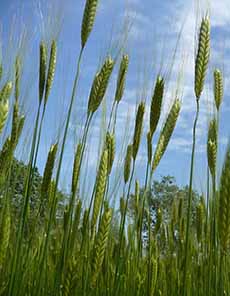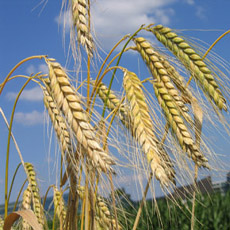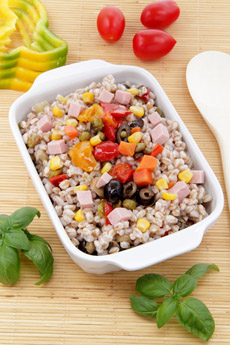TIP OF THE DAY: Farro, The Original Wheat & A Moroccan Chicken Recipe
|
With all the focus on quinoa as the “it” grain, don’t hold yourself back from trying other ancient grains.
Farro, an early, very tasty wheat subspecies, is also known as emmer wheat. Some people also confuse it with spelt (more about that below). But it shouldn’t keep you from seeking it out at better supermarkets, specialty food stores, natural foods stores, or online. If you don’t like the flavor of quinoa but want more nutrition, this is a must-try. Check out the recipes for Farro & Beet Salad and Moroccan Chicken With Farro-Carrot Salad below. An unhybridized ancestor of modern wheat, farro was one of the first grains cultivated by man in the Fertile Crescent, also known as The Cradle Of Civilization. Here’s more on the earliest cultivated crops. Farro was a mainstay of the daily diet in ancient Rome, and it sustained the Roman legions as they conquered Europe. It was an important staple in parts of Europe from the Bronze Age to medieval times. Because the yields aren’t as high as with other wheat species. Over the millennia, the tastier and more nutritious strains of many crops were abandoned in favor of strains and hybrids that produced greater yields and were less resistant to weather fluctuations, diseases, and pests. Farro ceased to be cultivated, except in a few remote areas. (This selective breeding process was also conducted with animal species, both food animals, work animals, and companion animals.) The growing interest in better-for-you foods has brought farro back. It’s easy to confuse farrow and spelt. Farro looks rather like spelt, another early species of wheat; but they are not the same. Farro is emmer wheat, the original wheat. The botanical name for farro and emmer wheat is Triticum dicoccum; spelt is Triticum spelta; the most common modern wheat is Triticum aestivum. |
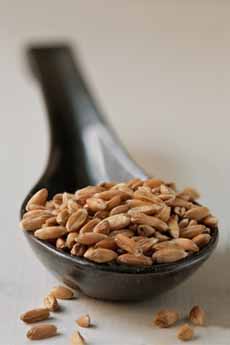 [1] Farro from Anson Mills is the finest farro, cultivated in the U.S. (photo © Anson Mills).
|
|
|
To be sure you’re getting whole grain farro, look for “whole” or “whole grain” on the label. “Pearled” or semi-pearled farro, which is quicker to cook, is not whole grain and lacks the fiber and nutrition from the germ and bran of whole grains.
Pearling removes the inedible hull that surrounds the grain, but the process also scours off part (semi-pearled) or all (pearled) of the nutritious germ and bran. Whole-grain farro is hulled using a gentler process that leaves the germ and bran intact. Today’s demands for better foods are bringing back some of the oldies. You can find: Fargo adds heft, mouth feel, and “chew” to recipes, or as a standalone side. You can serve it hot or cold, as a substitute for rice, quinoa, pasta, or other grain or starch. |
||
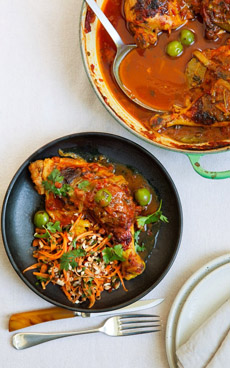 [4] Fragrant and flavorful: Braised Moroccan Chicken With Farro-Carrot Salad. The recipe is at right (photo and recipe © Good Eggs).
|
RECIPE: BRAISED MOROCCAN CHICKEN WITH FARRO-CARROT SALAD
This fork-tender braised chicken recipe from Good Eggs is packed with flavor and ready in an hour. Don’t be fooled by the number of ingredients: This dish is deceptively simple and easy to put together. Prep time is 15 minutes, cook time is 30 minutes. *Marash chile flakes are red pepper flakes from Turkey. They have a complex flavor—fruit and smoke—with moderate heat. Marash is both smokier and a bit hotter than Aleppo pepper, but you can use them interchangeably. If you can’t find either, substitute a mixture of Hungarian sweet paprika and cayenne pepper. The flakes can be blended with lemon juice and salt for a meat rub, or added to olive oil to make a vinaigrette, pasta, or rice sauce. Blend the flakes with olive oil for a bread dipper, and add to soups and stews, chili, or any meat dish. See the different types of chiles and the different types of peppercorns. |
|
|
Preparation 1. PREHEAT the oven to 350°F. Combine the spices—cumin, coriander, fennel, turmeric, cinnamon, and Marash chile—in a small bowl and set aside. Pat the chicken legs dry and season with salt, pepper, and about half of the spice mix. 2. ADD 2 tablespoons of olive oil (more if needed) to an oven-safe pan large enough to fit the chicken legs and all of the vegetables. Turn the heat to medium, and when the oil is hot add the diced onion, carrot, celery, and cilantro stems (not the leaves). Add a pinch of salt, the remaining spice mix, the dried espelette chile, and the bay leaves. Cook until the vegetables are completely soft and the onion is a bit translucent. 3. ADD half a can of crushed tomatoes and olives to the pan, then the chicken legs, skin-side up. Pour the chicken broth into the pan until the liquid is halfway up the chicken—you’ll want to leave some skin above the liquid so that it can crisp up in the oven. 4. BRING the ingredients to a boil on the stovetop, then place the entire pan uncovered on the middle or bottom rack of the oven (to prevent burning) for about 30 minutes. Check every 10 minutes to ensure that the skin is getting crispy but not burnt: The pan can be covered with aluminum foil or a lid if it is browning too quickly. If the chicken doesn’t seem to be browning at all, move it up a rack in the oven, but watch it closely. 5. REMOVE the pan from the oven after 30 minutes and check for doneness using a meat thermometer. The internal temperature should be 165°F. If not, place the pan back in the oven for another 5-10 minutes. When it’s done, set it aside to cool for 10 minutes. While the chicken is braising in the oven… 6. BRING a large pot of water to a boil. Season the water with 2 tablespoons of salt and add 2 cups of farro. Cook according to the package instructions until al dente, then drain and let cool. Toss with a bit of olive oil to help prevent clumping. 7. COMBINE the carrots, cilantro leaves, farro, almonds, a generous squeeze of lemon, and 1-2 tablespoons of olive oil in a mixing bowl. Toss gently and add salt and pepper to taste. Serve the farro salad alongside a chicken leg, with some braising liquid spooned over it. Try this Farro & Beet Salad recipe. CHECK OUT WHAT’S HAPPENING ON OUR HOME PAGE, THENIBBLE.COM.
|
||
